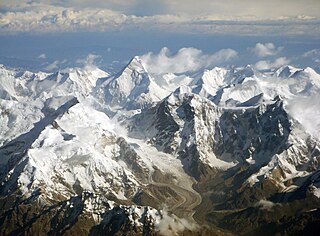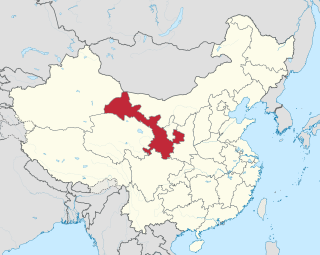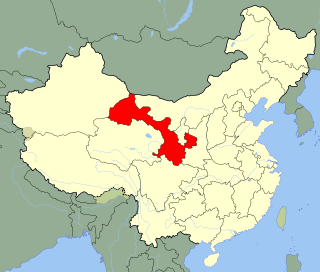The Dunhong (Chinese :敦薨) mountain, according to the Shanhaijing , is a mountain of the Tian Shan range.

Chinese is a group of related, but in many cases not mutually intelligible, language varieties, forming the Sinitic branch of the Sino-Tibetan language family. Chinese is spoken by the Han majority and many minority ethnic groups in China. About 1.2 billion people speak some form of Chinese as their first language.

The Tian Shan, also known as the Tengri Tagh, meaning the Mountains of Heaven or the Heavenly Mountain, is a large system of mountain ranges located in Central Asia. The highest peak in the Tian Shan is Jengish Chokusu, at 7,439 metres (24,406 ft) high. Its lowest point is the Turpan Depression, which sits at 154 m (505 ft) below sea level.
This mountain has been proposed to be the homeland of the Yuezhi. According to archaeologist Lin Meicun (林梅村), this is the Dunhuang (Chinese :燉煌) mentioned in the Shiji by Sima Qian, which states that:

The Yuezhi were an ancient Indo-European people first described in Chinese histories as nomadic pastoralists living in an arid grassland area in the western part of the modern Chinese province of Gansu, during the 1st millennium BC. After a major defeat by the Xiongnu in 176 BC, the Yuezhi split into two groups migrating in different directions: the Greater Yuezhi and Lesser Yuezhi.

Sima Qian was a Chinese historian of the early Han dynasty. He is considered the father of Chinese historiography for his Records of the Grand Historian, a Jizhuanti-style general history of China, covering more than two thousand years from the Yellow Emperor to his time, during the reign of Emperor Wu of Han, a work that had much influence for centuries afterwards on history-writing not only in China, but in Korea, Japan and Vietnam as well. Although he worked as the Court Astrologer, later generations refer to him as the Grand Historian for his monumental work; a work which in later generations would often only be somewhat tacitly or glancingly acknowledged as an achievement only made possible by his acceptance and endurance of punitive actions against him, including imprisonment, castration, and subjection to servility.
- The Yuezhi originally lived in the area between the Qilian Shan and Dunhuang, but after they were defeated by the Xiongnu they moved far away to the west, beyond Dayuan [the Ferghana Valley], where they attacked and conquered the people of Daxia [Bactria] ... [1]
Lin Meicun argued that the present Dunhuang (Chinese :敦煌, 燉煌), a Gansu oasis town, was founded around 111 BC, that is, later than the report of Zhang Qian on the Yuezhi (126 BC). Therefore the Dunhuan referred to in the Shiji cannot be the city currently bearing that name, and is most likely an oasis near Turpan.

Dunhuang is a county-level city in northwestern Gansu Province, Western China. The 2000 Chinese census reported a population of 187,578 in this city. Dunhuang was a major stop on the ancient Silk Road and is best known for the nearby Mogao Caves. It has also been known at times as Shazhou and, in Uyghur, Dukhan.

Gansu is a province of the People's Republic of China, located in the northwest of the country.

Zhang Qian was a Chinese official and diplomat who served as an imperial envoy to the world outside of China in the late 2nd century BC during the Han dynasty. He was the first official diplomat to bring back reliable information about Central Asia to the Chinese imperial court, then under Emperor Wu of Han, and played an important pioneering role in the Chinese colonization and conquest of the region now known as Xinjiang.
Place names such Dunhong and Qilian may have had Indo-European etymologies, from at two possible sources. For example:
- Lin Meicun suggested that Dunhuan is the Chinese spelling of Tushara (an Eastern Iranian people), and;
- Victor Mair noted the word kaelum in the Tocharian languages of the Tarim Basin, meaning "sky" or "heaven" (and therefore related distantly to the Latin caelum) which may have been the basis of qilian.

Tocharian, also spelled Tokharian, is an extinct branch of the Indo-European language family. It is known from manuscripts dating from the 6th to the 8th century AD, which were found in oasis cities on the northern edge of the Tarim Basin. The discovery of these languages in the early 20th century contradicted the formerly prevalent idea of an east–west division of the Indo-European language family on the centum–satem isogloss, and prompted reinvigorated study of the family. Identifying the authors with the Tokharoi people of ancient Bactria (Tokharistan), early authors called these languages "Tocharian". Although this identification is now generally considered mistaken, the name has remained.
According to a Tang Dynasty commentator on the Shiji, qilian was a Xiongnu word for "sky" – although Xiongnu may also have borrowed the word from an Indo-European language.












